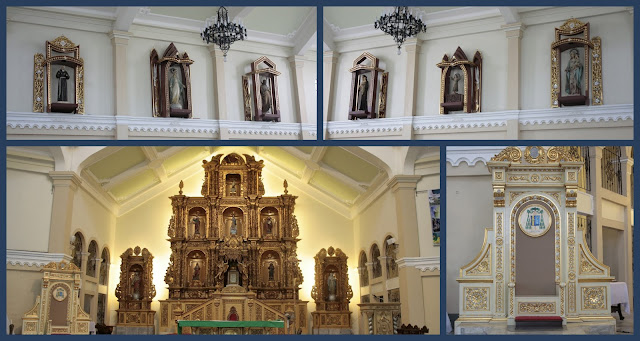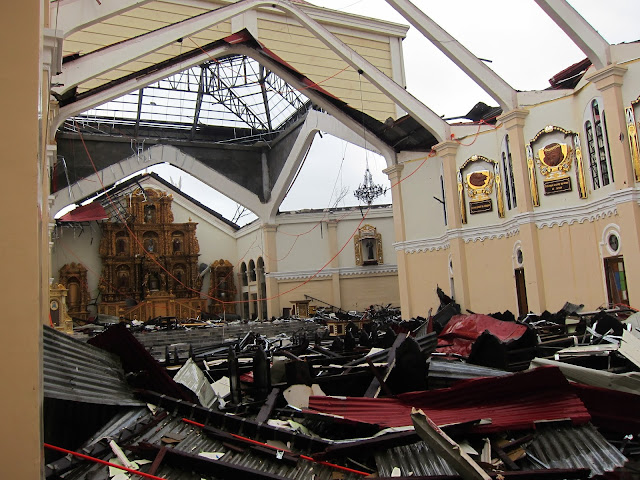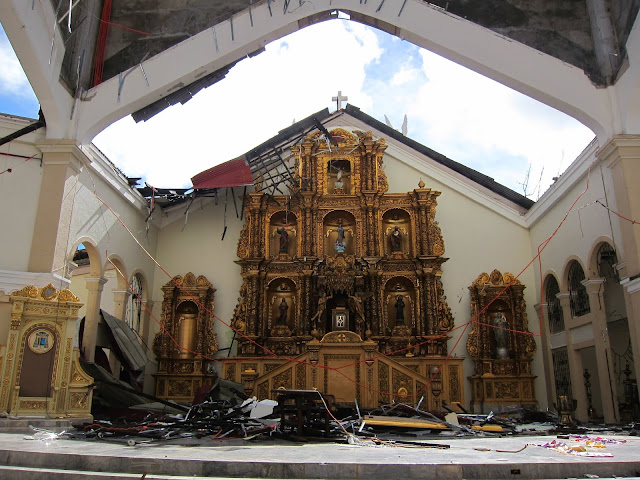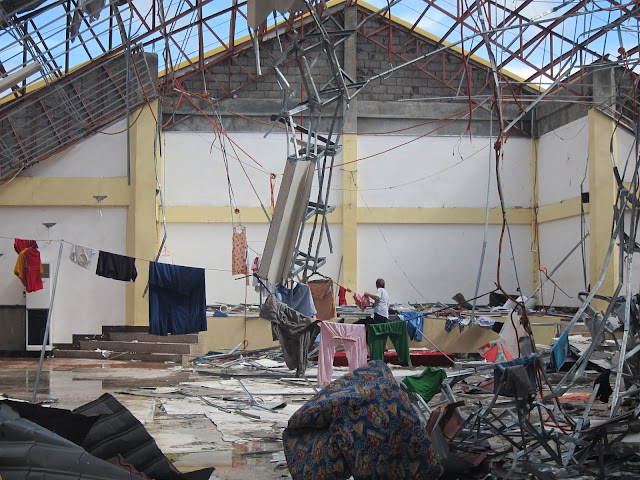When I was installed as the
parish priest of the Metropolitan Cathedral of Palo on January 12, 2010 the instruction given to
me by Archbishop Jose Palma was that I should prepare the Cathedral for the Diamond
Jubilee of the diocese. It was to be celebrated in less than three years on Nov. 27,
2012. Plans had already been made for a whole year of jubilee which would end a
year later. However, in the meantime, the Cathedral badly needed repairs. The Cathedral was already fast
deteriorating at that time with ceilings destroyed as water flowed freely
inside the Cathedral whenever it rained. The last major renovation of the
Cathedral was still in 1995.
This is how the Cathedral looked before the Renovation in 2010.
The Cathedral Facade


The left wing

The right wing

The main nave of the Cathedral
The ceilings were already destroyed because of the leaking. Whenever it rained the janitor had to mop the floor right away as church goers might slip and fall. Water also flowed down the stairs from the bell tower. At the meeting room at the back of the church altar, the ceilings were also destroyed and rainwater cascaded freely.
The state of the roofing of the Cathedral
The first thing that was
repaired was the roofing system. The contractor availed of for the repair of
the roofing was the Amis Industrial Development of Victor Amistoso from Manila.
He used a privately discovered and owned system of waterproofing and lamination
system to seal all the leaking parts of the roof. Since the most of the roofings were still
durable except for some parts, this system was availed of instead of replacing
the whole roof with a new one.
Archbishop
Palma wanted a general renovation of the Cathedral that would unify the topsy turvy architectural designs that were found in the Cathedral. While the designs for
the general renovation were still being deliberated, I also had the task of
finishing the construction of the Cathedral Rectory. In the early morning of
the fiesta of Palo on August 6, 2002, the Cathedral Rectory was razed to the
ground by a fire that started from the abandoned Chancery building which
was beside the rectory. For eight years the priests of the Cathedral used
the Sisters convent at the back of the burned rectory for their residence. Fr.
Stephen Pesado, the parish priest at the time decided to first construct a
function hall now called the Archbishop Cipriano V. Urgel Hall (ARCIVU Hall) at
the ruins of the old Chancery. Finished in 2004, the income derived from the
rentals of the ARCIVU Hall helped finance the construction of the rectory
which was started in 2005 during the time of Msgr. Ben Bacierra. Construction
slowly continued in the succeeding years. The project was halfway through when
I got assigned to the Cathedral. The Archbishop decided that for the expenses
of the Cathedral renovation all the parishes will be charged with a monthly
quota. Being freed of that worry, I was focused only in looking for funds for
the construction of the Rectory which I deemed should be finished before the
major renovation of the Cathedral would start. Seven months later during the fiesta celebration of August 6, 2010 Most Rev. Jose Palma blessed the
Parish Office and Private Chapel of the new rectory. This would be followed a
month later on Sept. 5, 2010 with the blessing of the dining room, bedrooms and
kitchen. The following month the renovation of the Cathedral started.
The half part of the Cathedral Rectory

The finished Cathedral Rectory.
Dining room
Corridor leading the dining room. In the middle of the convento was the ruins of the centuries-old convento which they left as a past reminder.

Private Chapel
Parish offices
Parish archives
The Archbishop chose
the design submitted by Arch. Gervasio Amistoso. It involved the construction
of a new dome to match the twin belfries, the enlargement of the canopy at the
main door and the opening of two doors besides it, the placement of mouldings
inside the church and the belfries and the change of ceiling to unify the
architectural design inside the Cathedral, among others. The major
reconstruction started by October 2010.
The design for the Cathedral approved by the Archbishop.
Work on the dome lasted for more than a year.

Uniform columns and mouldings were placed around the Cathedral.

The ceilings were also replaced.

Construction of a bigger canopy at the front of the church and placing of mouldings at the twin bell towers.

Canopies were also built at the side wings of the church

The main door of the Cathedral with a relief of the Transfiguration and the two new doors built beside it.
The main nave of the Cathedral

The baptismal font near the door of the Cathedral.
Four confessional boxes were built.
The right wing
The left wing
Entrance to the sacristy
The Gallery of Saints at the back of the left side wing of the Cathedral
The gallery at the back of the Altar

The new road fronting the Cathedral
The carved Stations of the Cross were
refurbished with gold plating and the titles of the stations were carved in
place of the meditations that were formerly painted on a plywood. New benches were not only added but the
benches at the wings were changed to match the benches at the nave. Four
airconditioned confessionals were installed; a baptistery was built near the main
entrance and a gallery of saints and place for votive candles was constructed.
Chandeliers along the main nave were installed to match the chandeliers on the
side wings. The sacristy was likewise renovated and a new bishop’s sacristy was
made out of the Burabod chapel across
the old sacristy. A new cathedra was installed
in time for the installation of the new archbishop, Most Rev. John F. Du in May 2012. A new altar
table and lectern were also put in place just before the Diamond Jubilee
celebration. A baptistery near the main door was also
constructed. To cap the whole renovation, a new road was constructed at the end
of the Sacred Heart Plaza fronting the Cathedral to be its new entrance so that
when one enters the Cathedral one could right away see the grandeur of its
newly renovated facade. The renovation was completed in time for the Diamond Jubilee celebration of the diocese on Nov. 27, 2012.
THE DIAMOND JUBILEE OF PALO AS A DIOCESE
November 27, 2012
Most Rev. John F. Du, Archbishop of Palo seated on his cathedra.
Cardinal Vidal was the main celebrant.
The former Archbishop, Most Rev. Jose Palma of Cebu was the homilist.
The Diamond Jubilee was well attended by bishops from all over the country and by representatives from every parish. The Cathedral was filled to the brim. Those that could not be accommodated inside were placed in tents fronting the Cathedral with LED walls for their active participation.
The archdiocese was
about to close the year-long Jubilee when super typhoon Yolanda came. On that
fateful day of November 8, 2013 super typhoon Yolanda packing more than 300
km. per hour winds blew away the dome and ripped off the roof of the whole
Cathedral. The Cathedral Rectory was also badly destroyed and the ARCIVU Hall
was totally wrecked. In less than a year since its renovation, the Cathedral was destroyed more than ever.
DESTRUCTION CAUSED BY SUPER TYPHOON YOLANDA
Only the statue of the Sacred Heart fell on its face while all the other statues stood in place inside the retablo and the niches on the side wings.

What remained of the Dome.

The Cathedral Rectory


The ARCIVU Hall
It was a blessing that no one died of those who were evacuating at the destroyed ARCIVU Hall. Abp. Du was also caught in the ARCIVU Hall during the rampage of the storm.



The Our Lady of Hope of Palo Chapel which is connected to the Cathedral.
The image of the Our Lady of Hope of Palo was carved by Willy Layug depicting the Blessed Virgin Mary and the child Jesus reaching a rosary to a distressed child that symbolizes the victims of the super typhoon Yolanda (Haiyan). The image is standing on a globe that is surrounded with waves (as allusion to the typhoon). This image was blessed by Pope Francis when he visited Tacloban in 2015.
.jpg)
The Palo Cathedral today after the renovation.



















































































.JPG)
.JPG)
.JPG)
.JPG)
.JPG)
a.jpg)
.JPG)
.JPG)
.JPG)